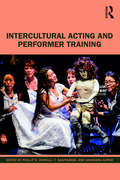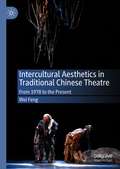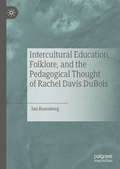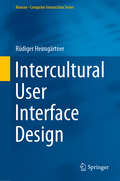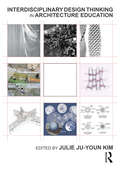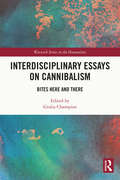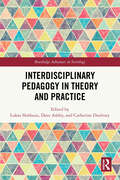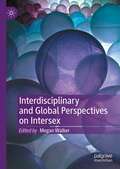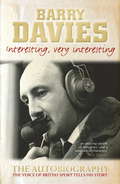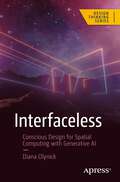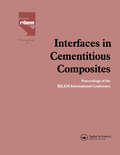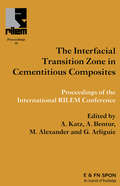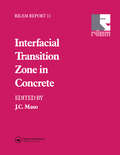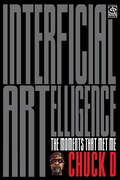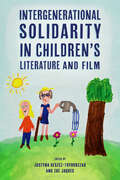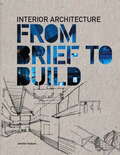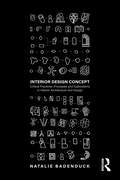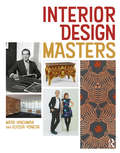- Table View
- List View
Intercultural Acting and Performer Training
by Zarrilli Phillip T Sasitharan Anuradha KapurIntercultural Acting and Performer Training is the first collection of essays from a diverse, international group of authors and practitioners focusing on intercultural acting and voice practices worldwide. This unique book invites performers and teachers of acting and performance to explore, describe, and interrogate the complexities of intercultural acting and actor/performer training taking place in our twenty-first century, globalized world. As global contexts become multi-, inter- and intra-cultural, assumptions about what acting "is" and what actor/performer training should be continue to be shaped by conventional modes, models, techniques and structures. This book examines how our understanding of interculturalism changes when we shift our focus from the obvious and highly visible aspects of production to the micro-level of training grounds, studios, and rehearsal rooms, where new forms of hybrid performance are emerging. Ideal for students, scholars and practitioners, Intercultural Acting and Performer Training offers a series of accessible and highly readable essays which reflect on acting and training processes through the lens offered by "new" forms of intercultural thought and practice.
Intercultural Aesthetics in Traditional Chinese Theatre: From 1978 to the Present
by Wei FengThis book traces the transformation of traditional Chinese theatre’s (xiqu) aesthetics during its encounters with Western drama and theatrical forms in both mainland China and Taiwan since 1978. Through analyzing both the text and performances of eight adapted plays from William Shakespeare, Bertolt Brecht, and Samuel Beckett, this book elaborates on significant changes taking place in playwriting, acting, scenography, and stage-audience relations stemming from intercultural appropriation. As exemplified by each chapter, during the intercultural dialogue of Chinese and foreign elements there exists one-sided dominance by either culture, fusion, and hybridity, which corresponds to the various facets of China’s pursuit of modernity between its traditional and Western influences.
Intercultural Education, Folklore, and the Pedagogical Thought of Rachel Davis DuBois
by Jan RosenbergThis book provides a history of the Quaker educator and intercultural education pioneer Rachel Davis DuBois (1892-1993) that explores the period in which DuBois lived and the key works she created. The opening section establishes the disciplinary contexts of her work, education, and folklore, and the subsequent sections present DuBois' pedagogical methods as they were developed and exemplified by her programs. Throughout the narrative, Rosenberg includes reflections on her own experience as a practitioner of the intercultural and folklife education DuBois championed.
Intercultural User Interface Design (Human–Computer Interaction Series)
by Rüdiger HeimgärtnerThe path for developing an internationally usable product with a human-machine interface is described in this textbook, from theory to conception and from design to practical implementation. The most important concepts in the fields of philosophy, communication, culture and Ethnocomputing as the basis of intercultural user interface design are explained. The book presents directly usable and implementable knowledge that is relevant for the processes of internationalization and localization of software. Aspects of software ergonomics, software engineering and human-centered design are presented in an intercultural context; general and concrete recommendations and checklists for immediate use in product design are also provided. Each chapter includes the target message, its motivation and theoretical justification as well as the practical methods to achieve the intended benefit from the respective topic. The book opens with an introduction illuminating the background necessary for taking culture into account in Human Computer Interaction (HCI) design. Definitions of concepts are followed by a historical overview of the importance of taking culture into account in HCI design. Subsequently, the structures, processes, methods, models, and approaches concerning the relationship between culture and HCI design are illustrated to cover the most important questions in practice.
Interdisciplinary Design Thinking in Architecture Education
by Kim, Julie Ju-YounThis book explores the creative potential for architecture curricula to integrate solid interdisciplinary thinking in design studio education. Annotated case studies, both from academic institutions and from professional practices, provide examples of interdisciplinary engagement in creative design work, highlighting the challenges and opportunities of this approach. Cases are from a diverse selection of international collaborators, featuring projects from the United States, Australia, Mexico, Germany, and Italy, and cover a range of project types and scales. Chapters by invited experts offer speculations on current and future models, situating examples within the broader context, and encouraging dialogue between practice and pedagogy. The collection of voices in this book offers critical and provocative lenses, learning from history while forging inventive and creative roles for the architect as practitioner, entrepreneur, strategist, choreographer, activist, facilitator, leader, and teacher. Interdisciplinary Design Thinking provides insights into the potential of interdisciplinary engagement at the level of foundational undergraduate education, making it ideal for faculty in architecture schools. It will also be of interest to design professionals concerned with interdisciplinary collaboration and how to incorporate similar efforts in their own practices.
Interdisciplinary Design Thinking in Architecture Education
by Kim, Julie Ju-YounThis book explores the creative potential for architecture curricula to integrate solid interdisciplinary thinking in design studio education.Annotated case studies, both from academic institutions and from professional practices, provide examples of interdisciplinary engagement in creative design work, highlighting the challenges and opportunities of this approach. Cases are from a diverse selection of international collaborators, featuring projects from the United States, Australia, Mexico, Germany, and Italy, and cover a range of project types and scales. Chapters by invited experts offer speculations on current and future models, situating examples within the broader context, and encouraging dialogue between practice and pedagogy. The collection of voices in this book offers critical and provocative lenses, learning from history while forging inventive and creative roles for the architect as practitioner, entrepreneur, strategist, choreographer, activist, facilitator, leader, and teacher.Interdisciplinary Design Thinking provides insights into the potential of interdisciplinary engagement at the level of foundational undergraduate education, making it ideal for faculty in architecture schools. It will also be of interest to design professionals concerned with interdisciplinary collaboration and how to incorporate similar efforts in their own practices.
Interdisciplinary Essays on Cannibalism: Bites Here and There (Warwick Series in the Humanities)
by Giulia ChampionInterdisciplinary Essays on Cannibalism: Bites Here and There brings together a range of works exploring the evolution of cannibalism, literally and metaphorically, diachronically and across disciplines. This edited collection aims to promote a conversation on the evolution and the different uses of the tropes and figures of cannibalism, in order to understand and deconstruct the fascination with anthropophagy, its continued afterlife and its relation to different disciplines and spaces of discourse. In order to do so, the contributing authors shed a new light not only on the concept, but also propose to explore cannibalism through new optics and theories. Spanning 15 chapters, the collection explores cannibalism across disciplines and fields from Antiquity to contemporary speculative fiction, considering history, anthropology, visual and film studies, philosophy, feminist theories, psychoanalysis and museum practices. This collection of thoughtful and thought-provoking scholarly contributions suggests the importance of cannibalism in understanding human history and social relations.
Interdisciplinary Pedagogy in Theory and Practice (Routledge Advances in Sociology)
by Catherine Duxbury Lukas Slothuus Dave AshbyThis book explores interdisciplinary university teaching in both theory and practice, drawing on the experience and expertise of educators from across the social sciences and humanities. Based around pedagogical theory and concrete practical examples and experiences from the classroom, the book contributes with a multiplicity of knowledge to the growing appetite for interdisciplinary initiatives at universities.The book is unique in offering depth and breadth of analysis of one of the most prominent experiments of interdisciplinary social science and humanities education in Britain, namely LSE100: The LSE Course, an interdisciplinary course taken by all undergraduates across disciplines at the London School of Economics and Political Science (LSE). The course has three streams, each addressing a major challenge of our time: The climate crisis, fairness, and artificial intelligence (AI).The book is of interest to academics, educators, and university leaders curious about developing and implementing interdisciplinary education in their own contexts, as well as to anyone interested in understanding the dynamics and challenges at stake in interdisciplinary educational settings. Finally, it appeals to students seeking to broaden their understanding of the social sciences beyond their own discipline.
Interdisciplinary and Global Perspectives on Intersex
by Megan WalkerThis edited collection interrogates how social and cultural representations of individuals with intersex variations impact how they are understood and treated from legal and medical perspectives across the world. Contributors consider how novelists, filmmakers, artists, and medical professionals have represented people with intersex variations, and highlight the importance of ethical representation and autonomy to encourage wider cultural and medical knowledge of intersex variations as a naturally occurring phenomenon. The text also examines the ways in which individuals with intersex variations are represented and viewed in India, Italy, Pakistan and Israel, as well as how this impacts decision making for the individuals, families and medical providers. This book argues that reactions to intersex variations will not change unless they are no longer presented as treatable disorders. It positions representation at the forefront, shifting the emphasis away from a concern for maintaining gender norms to upholding the human rights of intersex people. This volume will be of interest to researchers and scholars in intersex studies as well as policymakers and activists.
Interdisziplinäre Architektur-Wissenschaft: Eine Einführung (Interdisziplinäre Architektur-Wissenschaft: Praxis – Theorie – Methodologie – Forschung)
by Karsten Berr Achim HahnArchitektur, sichtbar und anschaulich, gestaltet baulich-technisch und räumlich unsere Lebensumwelt und stellt in dieser genuinen Eigenschaft eine besondere Herausforderung an die Wissenschaft(en) dar.Bei den versammelten Beiträgen dieses Bandes handelt es sich um die schriftlichen Fassungen von Vorträgen im Rahmen eines von der DFG finanzierten ‚Rundgesprächs‘ zum Thema ‚Interdisziplinäre Architektur-Wissenschaft‘ im Juni 2018 an der Technischen Universität Dresden – ergänzt von weiteren Autorinnen und Autoren.Der Band ist in vier thematische Schwerpunkte gegliedert. Der erste Teil präsentiert philosophische Grundlagen einer interdisziplinären Architektur-Wissenschaft. Der zweite Teil stellt aus unterschiedlichen disziplinären oder wissenschaftstheoretischen Ansätzen heraus wissenschaftstheoretische und methodologische Grundlagen und Zugriffe bereit. Der dritte Teil beleuchtet das Spannungsverhältnis von Architektur als Disziplin und Praxis zu Architekturtheorie und Architektur-Wissenschaft. Im vierten Teil werden exemplarisch Theoriebildung und Theorien zu Landschaft, Landschaftsforschung und Landschaftsarchitektur diskutiert.
Interesting, Very Interesting
by Barry DaviesBarry Davies' face and voice are instantly recognisable to any UK sports fan. He has guided audiences through some of the most compelling and exciting moments in televised sport over the past 40 years. Here, he relives the magic of those events and reveals what was going on behind the scenes. He has broadcast at a record 10 World Cup finals, and until stepping down in 2004 he was Match of the Days longest-serving commentator. But his expertise goes far beyond football: 10 Summer Olympic Games and numerous Winter Olympics, sharing in Torvill and Deans success in 1984 and heartbreak 10 years later. He is also synonymous with Wimbledon and the Boat Race. The controversies of sport are also addressed, from the Hand of God to crooked judges and professional rivalries off-screen, together with many light-hearted mishaps played out in front of millions of viewers.
Interesting, Very Interesting
by Barry DaviesBarry Davies' face and voice are instantly recognisable to any UK sports fan. He has guided audiences through some of the most compelling and exciting moments in televised sport over the past 40 years. Here, he relives the magic of those events and reveals what was going on behind the scenes. He has broadcast at a record 10 World Cup finals, and until stepping down in 2004 he was Match of the Days longest-serving commentator. But his expertise goes far beyond football: 10 Summer Olympic Games and numerous Winter Olympics, sharing in Torvill and Deans success in 1984 and heartbreak 10 years later. He is also synonymous with Wimbledon and the Boat Race. The controversies of sport are also addressed, from the Hand of God to crooked judges and professional rivalries off-screen, together with many light-hearted mishaps played out in front of millions of viewers.
Interfaceless: Conscious Design for Spatial Computing with Generative AI (Design Thinking)
by Diana OlynickExplore the possibilities spatial computing and its integration with AI can provide beyond the confines of a traditional user interface. Spatial computing brings together physical and virtual worlds and systems. This book offers an insightful journey into harmonizing user-centered design with the vast potential of AI in spatial computing. You'll start by exploring key concepts and processes in relation to conscious design and traditional computer interfaces. You'll then be introduced to the Mindful Spatial Design Framework (MSDF) and the rapidly evolving world of generative AI and its potential to transform design processes.Once the key concepts are mastered, you'll start to put them into practice and see how to design, prototype, and test interfaceless systems and environments that are seamless and user-friendly. In doing so you'll consider topics such as functionality and aesthetics, as well as how AI can improve automation and testing. The book concludes by looking at ethical AI considerations and best practices as well as looking at next steps and future developments of spatial computing and interfaceless design. As these invisible interfaces become more prevalent, understanding the key principles of conscious design is pivotal. Interfaceless will expand your knowledge base in these areas. What You'll LearnIncorporate conscious design principles in spatial computing projects.Leverage AI to enhance UX in spatial contexts.Develop strategies to address design challenges as we move beyond physical interfaces.See how VR/XR apps, devices, and generative AI are rapidly changing how we perceive and interact with the digital realm.Who This Book Is ForUX/UI designers, developers, and tech enthusiasts eager to grasp the future of HCI.
Interfaces in Cementitious Composites
by J.C. MasoThis book presents a series of high level contributions from leading research groups around the world in the field of cement and concrete science. It deals with the rapidly advancing subject of the interfaces between the components of cementitious materials: cements, aggregates, fibres, reinforcement. It will be valuable for all those involved with
Interfacial Transition Zone in Cementitious Composites
by M. Alexander A. Katz, A. Bentur G. ArliguieThis book addresses the need to resolve the ITZ's influence on engineering and durability characteristics of cementious composites, identifies the systems and properties that are affected by it, and quantifies these effects in order to prepare the base for engineering design tools. This volume presents the proceedings of the Second International RI
Interfacial Transition Zone in Concrete
by C. Maso JAn important state-of-the-art report prepared by RILEM Technical Committee 108 ICC. It has been written by a team of leading international experts from the UK, USA, Canada, Israel, Germany, Denmark, South Africa, Italy and France.
Interficial ARTelligence: The Moments That Met Me
by Chuck DLegendary hip-hop artist Chuck D (Public Enemy, Prophets of Rage) details and illustrates his encounters with some of society’s most influential musicians, entertainers, politicians, athletes, and public figures. In Interficial ARTelligence: Moments That Met Me, Chuck D presents his encounters with some of his greatest heroes and other public figures. These seminal moments in Chuck D’s life include: an editorial meeting with John F. Kennedy Jr.; presenting an award to Davie Bowie; being recruited by Will Ferrell and Adam McKay to act in a film; eating chips and guac with Quincy Jones; being inducted into the Rock & Roll Hall of Fame by Harry Belafonte; lobbying on Capitol Hill with Anita Baker; musical collaborations with Prince, Sheryl Crow, Janet Jackson, Erykah Badu, and John Mellencamp; and visiting Mumia Abu-Jamal in prison. Chuck D says, “For a PErson like myself—an aged distance beyond a half century of life on Earth—I have experienced a vast array of PEople, PlacEs & Things. The memories are always a looping swirl in my mind. I’m often asked about them and I consider myself a decent storyteller. As an illustrator, I’m able to recreate that point of view as I saw it. So Interficial ARTelligence: Moments That Met Me is a tale with images from my PErspective in a time when so many people listen with their eyes.” Chuck’s beautiful illustrations and remarkable commentary also include his cross-pollinations with: music industry titans like Berry Gordy and Ahmet Ertegun; musical icons Madonna, the Notorious B.I.G., the Rolling Stones, Gladys Knight, Smokey Robinson, Mavis Staples, Michael Stipe, Ice Cube, Patti LaBelle, Lenny Kravitz, and LL Cool J; athletes Michael Jordan, Shaquille O’Neal, Julius Erving, Barry Bonds, and Barry Sanders; entertainers/actors Oprah Winfrey, Joan Rivers, Jeremy Piven, Dick Gregory, Robin Williams, Warren Beaty, Alec Baldwin, Eddie Murphy, Jamie Foxx, and Spike Lee; political figures like Angela Davis and Jesse Jackson; and many more.
Intergenerational Solidarity in Children’s Literature and Film (Children's Literature Association Series)
by Justyna Deszcz-Tryhubczak and Zoe JaquesWinner of the 2023 Edited Book Award from the International Research Society for Children's LiteratureContributions by Aneesh Barai, Clémentine Beauvais, Justyna Deszcz-Tryhubczak, Terri Doughty, Aneta Dybska, Blanka Grzegorczyk, Zoe Jaques, Vanessa Joosen, Maria Nikolajeva, Marek Oziewicz, Ashley N. Reese, Malini Roy, Sabine Steels, Lucy Stone, Björn Sundmark, Michelle Superle, Nozomi Uematsu, Anastasia Ulanowicz, Helma van Lierop-Debrauwer, and Jean Webb Intergenerational solidarity is a vital element of societal relationships that ensures survival of humanity. It connects generations, fostering transfer of common values, cumulative knowledge, experience, and culture essential to human development. In the face of global aging, changing family structures, family separations, economic insecurity, and political trends pitting young and old against each other, intergenerational solidarity is now, more than ever, a pressing need. Intergenerational Solidarity in Children’s Literature and Film argues that productions for young audiences can stimulate intellectual and emotional connections between generations by representing intergenerational solidarity. For example, one essayist focuses on Disney films, which have shown a long-time commitment to variously highlighting, and then conservatively healing, fissures between generations. However, Disney-Pixar’s Up and Coco instead portray intergenerational alliances—young collaborating with old, the living working alongside the dead—as necessary to achieving goals. The collection also testifies to the cultural, social, and political significance of children’s culture in the development of generational intelligence and empathy towards age-others and positions the field of children’s literature studies as a site of intergenerational solidarity, opening possibilities for a new socially consequential inquiry into the culture of childhood.
Interior Architecture: From Brief to Build
by Jennifer HudsonInterior Architecture provides an in-depth study of the creative and construction processes behind 30 contemporary interior designs. Covering a broad range of international projects, the book illustrates the working methods and creative concerns of both long-established and emerging international designers. Every stage of the project is included, from the demands of the original brief, through early sketches and design development to investigation of building regulations and collaboration with engineers, contractors, builders, and suppliers. Each project is presented through an explanatory overview, shots of production and construction processes, and details of fixtures, fittings, customized furnishings, and decoration. Interior Architecture offers both students and professional designers, an inspiring and informative overview of how today's major interior architectural projects are designed and built.
Interior Architecture: From Brief to Build
by Jennifer HudsonInterior Architecture provides an in-depth study of the creative and construction processes behind 30 contemporary interior designs. Covering a broad range of international projects, the book illustrates the working methods and creative concerns of both long-established and emerging international designers. Every stage of the project is included, from the demands of the original brief, through early sketches and design development to investigation of building regulations and collaboration with engineers, contractors, builders, and suppliers. Each project is presented through an explanatory overview, shots of production and construction processes, and details of fixtures, fittings, customized furnishings, and decoration. Interior Architecture offers both students and professional designers, an inspiring and informative overview of how today's major interior architectural projects are designed and built.
Interior Design
by John F. PileA comprehensive, applications-oriented introduction to the evolving field of interior design, with a focus on the challenges facing designers in the 21st century.
Interior Design Clients: The Designer's Guide to Building and Keeping a Great Clientele
by Thomas L. WilliamsClients are the lifeblood of any interior design firm and a sound understanding of how to manage those clients is essential. Interior Design Clients is an informative yet fun read for entrepreneurial designers interested in gaining a better understanding of how to build and manage their clientele. Tom Williams, designer, author, and blogger, deconstructs the pitfalls and challenges that can waylay even seasoned designers. As many professional designers learn, clients can be intimidated by interior designers and sometimes can even be fearful of the process. This unreasonable intimidation can often hinder the designer-client relationship and can even stop clients from asking for what they want. This leads to clients being unsatisfied and then walking away with a negative impression of their designer. Learning why clients fear their interior designer and developing strategies to allay those fears is essential for gaining and keeping a satisfied clientele. Everything from good client, project, and time management to interview techniques and staff and paperwork organization can all lead to making client interaction as rewarding as possible and are important aspects of the business rarely addressed by the interior design community as a whole. Interior Design Clients covers the subjects rarely taught in design schools such as specific presentation and interview skills and how to sell to market. Through frank discussion and practical examples, Williams weaves the art of selling into his lessons on interviewing, presenting, and pleasing the client as a natural part of the design process. Becoming a residential or commercial interior designer is not an easy undertaking, but Thomas Williams' Interior Design Clients: The Designer's Guide to Building and Keeping a Great Clientele provides the fundamental lessons and innovative solutions to help designers succeed in the ultra-competitive world of modern interior design.
Interior Design Concept: Critical Practices, Processes and Explorations in Interior Architecture and Design
by Natalie BadenduckInterior Design Concept combines a comprehensive introduction to design concept, with a reflective examination upon the various ways it can be understood, harnessed, and implemented. Within interior architecture and design, the power of conceptual thinking to fuel creativity, innovation, and collaboration is evident in the use of design concept. Broadly accepted as an essential component in the design process, design concept is a notoriously elusive topic which has, until now, received little critical attention. This book offers a reevaluation of current academic ideas about design methodologies and the nature of inspiration, alongside brand-new data from an international research study to help clarify what creativity really means in the modern world. Topics addressed throughout this text will examine the functions and definitions of design concept, analyze how it may be identified and integrated within the design process, investigate from where ideas for design concepts can emerge and, lastly, consider how ideas about them might be communicated in various ways. This book offers students, educators, and practitioners a concise explanation of what design concept is, why it plays such an integral role in the design process, and how it is utilized by interior architects and designers.
Interior Design Illustrated
by Francis D. Ching Corky BinggeliThe bestselling guide to interior design, updated with new code and technology Interior Design Illustrated is the definitive guide to design for interior spaces. Richly illustrated in author Francis Ching’s signature style, this book introduces complex design concepts in a visually stunning format; from defining the space and using the elements of design, to planning building systems and incorporating sustainable materials, this volume embodies the idea that beauty and function are not separate entities, but two parts of a whole. This new fourth edition has been updated to reflect the latest building codes and design practices, with discussion of new materials related to acoustics, lighting, and sustainable furnishings. Renewed attention to sustainability includes new information on energy conservation, design for longevity and adaptive reuse of existing buildings, as well as an updated discussion on LED lighting, workplace design, use of color, and computer modeling software to provide a well-rounded view of how interior design firms are working today. This classic text brings the elements and principles of design to life, giving students the practical skills they need to transition from idea to concept. Understand the latest building codes and how to integrate them into your design Explore new advances in materials, lighting, and wireless technology Design from a perspective of sustainability, longevity, and energy efficiency Delve into BIM, including software for modeling lighting, acoustics, and more Interior designers work at the intersection of aesthetics, functionality, regulations, accessibility, sustainability, and technology. There’s no one formula for getting it right, only an eye trained by experience, based on a mastery of design fundamentals. Interior Design Illustrated begins laying that foundation, guided by a leading global authority in the field.
Interior Design Masters
by Mark Hinchman Elyssa YonedaInterior Design Masters contains 300 biographical entries of people who have significantly impacted design. They are the people, historical and contemporary, that students and practitioners should know. Coverage starts in the late Renaissance, with a focus on the twentieth and twenty-first centuries. The book has five sections, with the entries alphabetical in each, so it can serve as a history textbook and a reference guide. The seventeeth- and eighteenth-century section covers figures from Thomas Chippendale to Horace Walpole. The nineteenth-century section includes William Morris and Candace Wheeler. The early twentieth-century section presents modernism’s design heroes, including Marcel Breuer, Eileen Gray, and Gilbert Rohde. The post-World War II designers range from Madeleine Castaing to Raymond Loewy. The final contemporary section includes Ron Arad and the Bouroullec brothers. These are the canonical figures who belong to any design history. The book also contains less well-known figures who deserve attention, such as Betty Joel, the British art deco furniture designer; Paul Veysseyre, the Frenchman active in China in the 1930s; and more recently Lanzavecchia-Wai, the Italian-Singaporean duo whose work ranges from health care to helicopters. Global in its coverage, the book is richly illustrated with over 600 black-and-white and color photographs.
